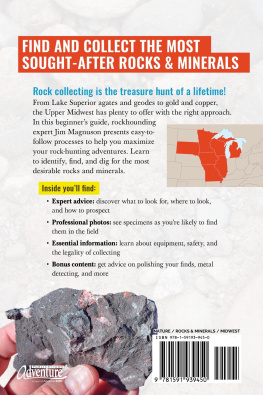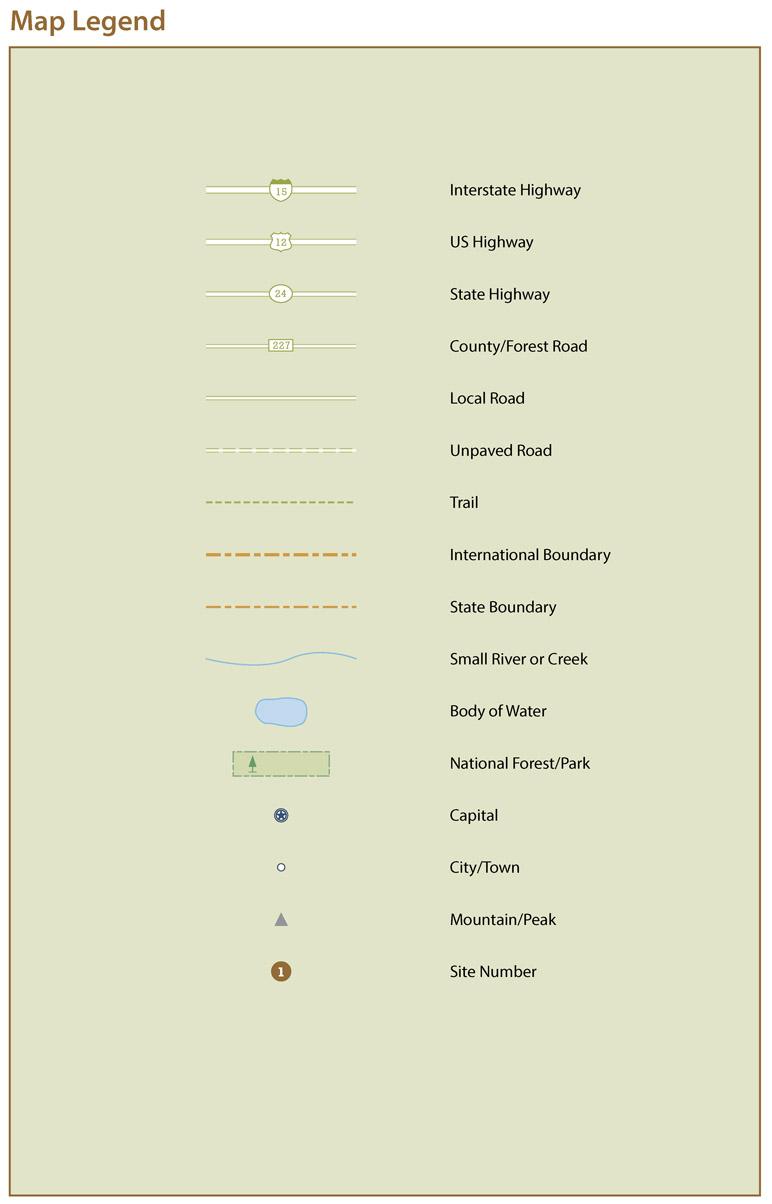ABOUT THE AUTHOR
Partially due to her patriotic name, Montana Hodges has traveled throughout the western United States as a geologist and freelance writer. Her works include a series of camping, hiking, and rockhounding books for FalconGuides. She received her masters in science journalism at the University of Montana and currently lives in Missoula, where she is working on her PhD in paleontology and anxiously awaiting the day royalties exceed expenses.
ACKNOWLEDGMENTS
F irst and foremost I would like to thank Mom and Dad. Had they named me Virginia, things would have been so different. A special thanks to Dad, who has inspired me to go outside and explore the natural world since I was a child. He brought science to my life and a love of open space to my soul. And a special thanks to Mom, who has given me the strength and ambition to follow my dreams and the attitude to make it all come true.
Thanks to the author of the first edition of Rockhounding Montana, Robert Feldman, who lent great help to the second edition, who became the inspiration for my PhD, and who was responsible for the geologic integrity of Falcon rockhounding guides. He really helped me keep my strata straight and he will be missed.
Also a due thanks to my geologic field assistantsJessica McCartney, Amy Singer, Emilia Palenius, Taylor Grage, Tanis Harty, Joey Latsha, Matt Blancas, Kip Sikora, and Ted Stevens. It is nearly impossible to properly express my gratitude to the geology department at Cal State Sacramento, particularly to the department chair, Dr. Dave Evans, who assured all the support a student in the field could ever dream of, not to mention the proper equipment. He was also responsible for the help of technician Steve Rounds, the geologist who spent much time identifying my many mysterious rocks and minerals. Thank you, Steveyou rock.
Of course, the biggest thanks to all the rock hounds, without whom life would be so dull. Hopefully this book will bring many adventures and trips filled with happiness and, of course, rock hounds will want to pass it on to a friend. See you in the field!
Montana Hodges
APPENDIX A: GLOSSARY
agate: A variety of chalcedony closely related to opal that is often translucent and found in a variety of colors and patterns.
amethyst: A purple or violet variety of quartz often used as a gem.
ammonite: An extinct group of mollusks that may have been similar to the present-day chambered nautilus.
anticline: An upturned fold in the rocks of the earths crust.
aquamarine: A blue-green gem variety of beryl.
azurite: A blue copper carbonate often associated with malachite.
Baculites: An extinct cephalopod thats similar to ammonites but is straight rather than curled.
barite: Barium sulfate occurring in blue, green, brown, and red colors.
batholith: A large mass of plutonic rock many tens of square miles in area.
belemnite: An extinct cephalopod possessing a cigar-shaped protective guard.
beryl: Beryllium aluminum sulphate that is generally colorless in its pure form; varieties include blues, pinks, greens, and yellows. Beryl constitutes such precious gems as emerald and aquamarine.
brachiopod: A marine animal with two unequal shells showing bilateral symmetry.
breccia: Angular rock fragments cemented into solid rock.
bryozoans: Small colonial animals that build calcareous structures in which they live.
cabochon: A gemstone that has been fashioned into a dome and polished.
calcite: A common crystalline form of calcium carbonate that is usually white or gray.
cephalopods: A class of mollusks that includes the squid, the octopus, and the chambered nautilus.
chalcedony: A microcrystalline variety of quartz.
chert: An extremely fine-grained siliceous rock exhibiting many colors.
columnal: A portion of the column, or stem, of crinoids.
concretion: A nodular lumpy rock, generally sedimentary, that forms about a nucleus (often a fossil).
country rock: The common rock surrounding another deposit of material.
crinoid: A flowerlike echinoderm with a multi-armed calyx, or head, and a long column, or stem, attaching it to the seafloor.
dendrite: A treelike pattern produced when minerals (usually oxides of manganese) crystallize in minute fractures in the rocks.
diastrophic: Natural processes that deform the earths crust (tension and compression that produce faults, folds, etc.).
dike: An igneous intrusion that cuts across preexisting rock layers.
echinoderm: A phylum of marine invertebrates with spiny bodies, including starfishes, sea urchins, and sea cucumbers.
echinoids: A class of echinoderms that includes the sand dollar and sea urchin.
epidote: A green monoclinic mineral with crystals that are often used as gemstones.
fault: A break or fracture in the earths crust along which movement takes place.
feldspar: The most widespread mineral group occurring in shades of white, gray, and pink in all kinds of rock.
fluorite: A clear-to-translucent mineral commonly occurring in shades of blue or purple as a common mineral in veins, which can be found in cubic crystals.
fossil: The remains of plants or animals preserved in rocks.
fossiliferous: Containing fossils.
garnet: Any mineral of the garnet group, commonly used as an abrasive.
Garnet also occurs as a pink-red semiprecious gem commonly cut into stones.
gastropod: A type of mollusk with an asymmetrical unchambered shell.
gem: A general term for a variety of stones that can be cut for ornamental purposes.
genus: One of the divisions in the classification of living things (or fossils).
geode: A hollow nodule or concretion that may contain crystals.
geology: The science that studies the earth, its composition, the processes that affect the rocks of which it is composed, and its history.
geomorphology: The geologic study that deals with the shape of the earths surface and the development of landforms.
gradation: A natural process such as weathering, erosion, or deposition that helps to shape the surface of the earth.
gypsum: A widely distributed mineral consisting of hydrous calcium sulfate that commonly forms in thick beds and occurs in shades of transparent (selenite), red, brown, and gray.
hydrothermal: Processes involving the action of hot-water solutions.
igneous: Rock that hardened from a molten state.
intrusion: Igneous rock that was intruded into preexisting rocks.
jasper: A variety of chert associated with iron ore that typically occurs in the color of red.
laccolith: An igneous intrusion that has squeezed between older rock layers and has domed up the overlying strata.
lapidary: The art or artist who fashions gemstones from rough rock.
limonite: A general term for a group of brownish iron hydroxide, commonly a secondary mineral due to oxidation of iron-bearing minerals.
malachite: A green copper ore that occurs in crystal and massive forms.
metamorphic: Rocks that have undergone physical and chemical change due to extreme changes in temperature and pressure.




